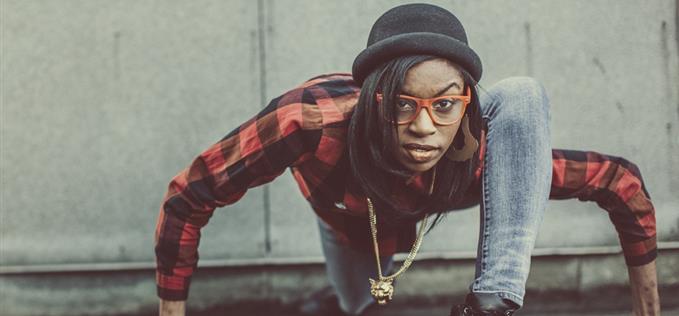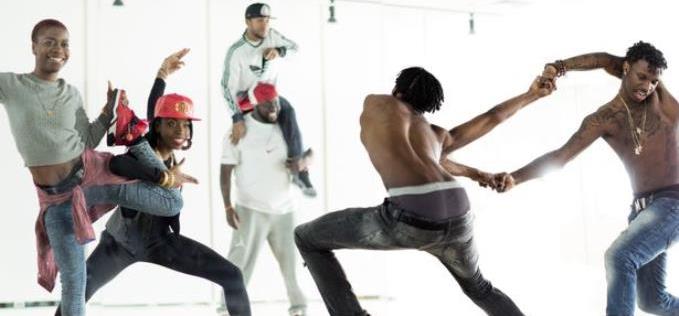‘FLEXING’ by definition means to bend or ‘become bent’.
When I’m dancing I become The Hulk
Drop the ‘I’ and ‘G’ and you get ‘FlexN’, the underground dance-style born out of Brooklyn, New York. Add in styles ‘pauzin’, ‘waving’, ‘connectin’, ‘hat-tricking’ and ‘bone-breaking’ and you have a zany combination of contortioning and hip-hop.
Here, what it means ‘to flex’, or rather ‘become bent’ is a quite literal definition.
With origins from Jamaican dancehall ‘bruk’-up (which again appropiately means, 'broke up'), the techniques were adopted by a troupe of malleable-bodied New Yorkers who have met much success in both the art and underground dance world.
FlexN now headline Manchester International Festival after Director Alex Poots spotted the ‘artistically developed’ dancers in New York. They've promised a transatlantic exchange and will debut ten selected Manchester-based dancers in their upcoming shows.
Ahead of what would be their first European perfomance, FlexN’s director and pioneer Reggie ‘Roc’ Gray and lead dancer, Deidra Braz, explain the language of FlexN to an otherwise illiterate audience. So what of this bone-breaking?
 FlexN
FlexNWhat were you looking for in your Manchester dancers?
Deidra: “We’re not trying to give them a new style or change their style. We took their abilities and figured out how we could work together. What we did was give them the foundations of FlexN and figured out how we could combine the styles so we matched."
Reggie: "The freestyle element is important to FlexN. With the Manchester dancers we wanted to explore their natural ability, combine what they already have and create something different. As Deidra says, the plan wasn’t to change them, it was to teach them dancing comes from within first. It’s more than just copying moves or looking in the mirror. The passion from dance comes from deep within a dancer. That’s the difference."
How important was it for the Manchester dancers to travel to New York?
D: "It was incredibly important for them to see where it came from – it’s almost the most important thing when learning the style. You hear the stories and get a sense of us, the feeling. FlexN is more than just about the moves it is about the culture that created it."
 Deidra - 'water hitting ice'
Deidra - 'water hitting ice'Summarise a FlexN performance:
R: "Watching FlexN is like watching a movie. It’s completely cinematic. Emotive. It’s anger. It’s passion. An entire range of emotions. It’s an opportunity for dancers to show a character, different aspects of their personality. Completely transform."
You transform into characters? Which do you turn in to?
R: (Laughs) "Well, in person as you’ll see I’m a calm and mellow character. I’m smooth. As Deidra will tell you, when I’m dancing I become The Hulk. It largely depends on the music, yet even if the music is mellow I’m still a Hulk - just a calm Hulk."
So Reggie transforms into The Hulk - how about Deidra?
D: "Firstly I would define my style of dance as waving, incorporated with the Jamaican bruk-up style. To wave, I have to move like water. I was once asked to describe my style of dance and I found it incredibly difficult but the best description came from Reggie; he said I was like ‘water crashing into ice’ because I can be both hard and soft. So I’ll stick with that. I’m happy with that description."
Do you have a signature move?
R: "You have to see it. It’s not something you can explain."
 Bone-breaking
Bone-breakingHow difficult was it to adopt the style? Did you train in a school?
R: "For me, I’ve had no other training than on the streets. It was in Brooklyn, at the Bloc Parties, where I discovered the Jamaican style Bruk-Up, this lead to FlexN. From there I developed my own style 'Pausing'."
D: "I similarly started learning from street culture - everything from the bogul to the running man. The only formal training I had was in college - I majored in dance, so I started late."
Describe the FlexN style in one word:
R: "It is incredibly difficult to summarise it. And I wouldn’t want to cheapen it by using buzzwords like ‘DYNAMIC’ or ‘EXCITING’. It’s a combination of many things."
D: "I would say ‘real’. FLEXN is raw: from topics we’ll explore to how we deliver it. These are our stories. With FlexN we can communicate a message and a culture."
How easily can underground dance translate to the stage?
R: "We’ve been prepared for many years, since we were young, to bring street performances to big stages. We’re able to combine all our experiences, abilities, stories and it works and in many ways can be considered a ‘high-art’ – by whatever you consider ‘high art’ to mean."
Street dance tends to use a lot of freestyle, should we expect choreography?
R: "I think first of all, we shouldn’t stereotype the word ‘street’, or indeed anything considered urban. The ‘streets’ have brought out the best people; entrepreneurs, businessmen, creators, who all create amazing things and bring a lot to wider communities. So you can’t assume that a street performance won’t be elegant, or that it won’t be technical.
"There are those who attend a dance performance for the technique and they want to see technical ability. They want to see choreographed steps. What you’ll get from FlexN is a little bit of us. It’s completely raw emotion. You feel what we feel."
Bone-breaking looks seriously painful – how easy is it to master?
Reggie: (Laughs) "Bone Breaking is a big stretch, basically. A really, really deep stretch. So the dancers train by constant stretching.
"In a FlexN performance Bone Breaking is the wow factor, the power move. Where in ballet a dancer may bring out a pirouette, we’ll bring out bone-breaking. But FlexN shouldn’t be defined by bone-breaking – put that in big capital letters. There’s so many more dance styles."
Is FlexN for everyone?
R: "Why wouldn’t it be open for everybody?"
Find out more about FlexN and tickets for their Manchester International Festival performance on our MIF 2015 page.















